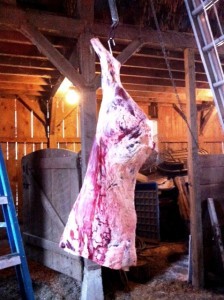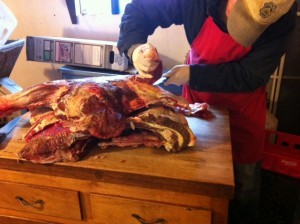Firsts appeared on Food Riot, by Sara Bir
There's a sound, a wonderful subtle sound, that a sharp knife makes when it slides between lobes of cow muscle. It's not gory or cartoonish at all, like the amplified sound effects in a zombie flick, but closer to the trickling of a narrow, shallow stream over rocks.

Cows, as we know, are really big. It takes a long time -- days, if you are working alone-to separate a slaughtered cow into its various primal and sub-primal cuts. Very few of us ever get to do this. The meat we buy at the grocery store is usually fabricated into cuts for us. You unwrap it, discard the Styrofoam tray and that gross bloody diaper thing, then simply toss the ground or cubed flesh into a hot skillet. Actually butchering meat is tedious work, elemental and too often unfamiliar, but it's also one of the most thrilling things a person can do.
I got the chance to do a little butchering recently, when my friend Kyle and his father killed their cow, their first in years. Slaughtering a cow on a small family farm is not the sort of thing you can cross off your to-do list in a fraction of an afternoon. There are all kinds of factors to consider: the weather (cold is good, warm is not), the strength of the help you have available, the following days of operating meat saws, vacuum sealers, pulleys, hooks.
By the time I arrived at the farm, June the cow's carcass was split into four parts; her salted hide was spread in the loft of the barn, her nose and udder still identifiable. Kyle was cutting up the neighborhood around and including her front leg (highlights: chuck, brisket, shank). Did I want to help out for a while? Yes and yes.
What followed was one of the best mornings in my life. I reconnected with that rarified, unexpectedly refined art of butchery. As a lazy vegetarian, a sausagetarian, I'd forgotten this truth. When I was in cooking school in the late 1990s, the first class we actually got to use our knives was Meat Identification, usually shortened to Meat I.D. On Day 1, we all took turns breaking down a gigantic round of beef (a primal) into more manageable sub-primals: top round, bottom round. Sinking my knife into that maroon-hued mass of meat -- which hung from a sturdy hook like a bulky winter coat or tire swing -- and the crumbly adipose fat surrounding it produced an adrenaline rush, startling and powerful. Instantly I gave myself over to that round of beef and the many different animal parts followed: loins of lamb, shoulders of veal, sides of pork. The poultry, with its flaccid flesh and droopy, pimpled skin, didn't have the same emotional potency.
 I think it's because of the kinship we more developed mammals have with other, seemingly less developed mammals. The parts are familiar, intimate, immediate. Kyle, who in his non-farm life is a massage therapist and practitioner of Tibetan medicine, kept on pointing out different highlights of June's anatomy as we disassembled her into increasingly less cow-like parts. "There's her tibia and fibia," he said after I'd coaxed her elbow and front leg bones away from the muscles surrounding them. And, like massage, the craft of butchery is not crude; we there to separate, not beat up, June's body. A true butcher lets the meat speak to her. She looks carefully at the connective tissue and the grain of the muscles and follows those like a hiker follows a creek. Charts and diagrams help, but when it comes down to it, it's just you and a dead animal. If you listen, the animal will tell your knife where to go.
I think it's because of the kinship we more developed mammals have with other, seemingly less developed mammals. The parts are familiar, intimate, immediate. Kyle, who in his non-farm life is a massage therapist and practitioner of Tibetan medicine, kept on pointing out different highlights of June's anatomy as we disassembled her into increasingly less cow-like parts. "There's her tibia and fibia," he said after I'd coaxed her elbow and front leg bones away from the muscles surrounding them. And, like massage, the craft of butchery is not crude; we there to separate, not beat up, June's body. A true butcher lets the meat speak to her. She looks carefully at the connective tissue and the grain of the muscles and follows those like a hiker follows a creek. Charts and diagrams help, but when it comes down to it, it's just you and a dead animal. If you listen, the animal will tell your knife where to go.
In the midst of all this new age yahooism, we were having what felt like an impromptu party in the farm's meat room. There was little talk, much concentration, and an abundance of intoxicating purpose. My friend Kelly, who assisted at June's still-fresh methodical demise, plugged an iPod into the heavy-duty meat room boom box and, low and behold, Echo & The Bunnymen's "The Cutter" popped right up on the shuffle.
This sort of boutique-minded foodie day-tripping is an easy target for eye-rollers and detractors, as well as PETA members. But we're all part of the same team, here to learn, not to shock. Here because we respect the lives of animals and pay homage to them in our own, very different ways. We're all disgusted and disappointed in the realities of industrially-raised meat. We're all tired of being isolated from the things we put in our mouths. We all want a feeling of control, an illusion of control.
I had engagements to attend to, and was not able to assist Kyle and Kelly for more than an hour. We'd barely made much headway with the shoulder when I drove down the long, rambling gravel farm driveway to get back onto the highway, then the Interstate, then my unexceptional life of shrink-wrapped meat chunks atop bloody diapers. If June has a successor arrive on the farm this spring, I've resolved to clear my calendar for slaughter, that demanding and logistically boggling time when life becomes meat and the life we take from the farm nourish our souls.
Again and again we hear talk about how disconnected we are from our food sources, how that translates into regarding food as a product rather than once-living things that required resources and attention. But no one mentions how we miss out on the pleasures of breaking down those animals into usable bits. It's not for the squeamish or impatient, but for the curious and determined, it rivals a trip to the spa.
Read more on Food Riot